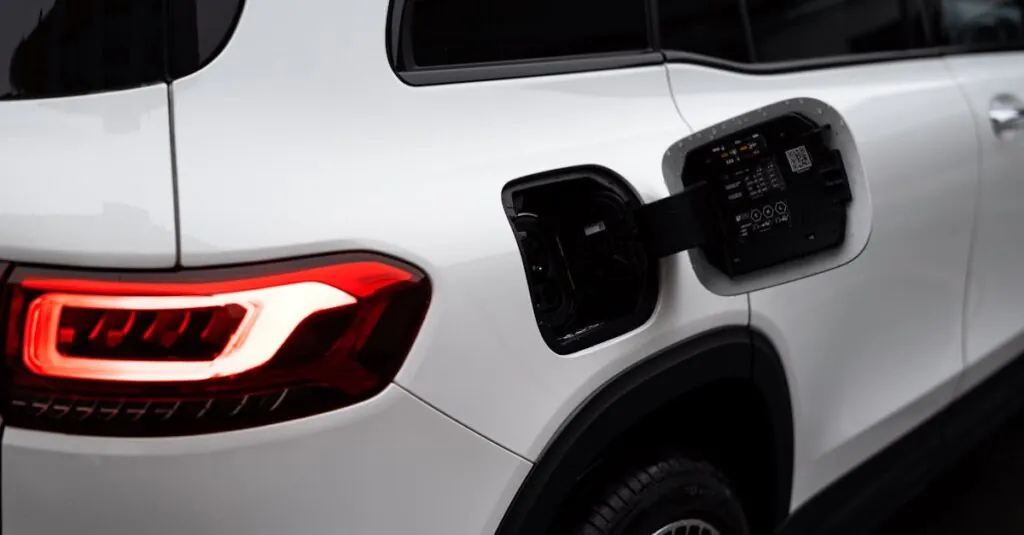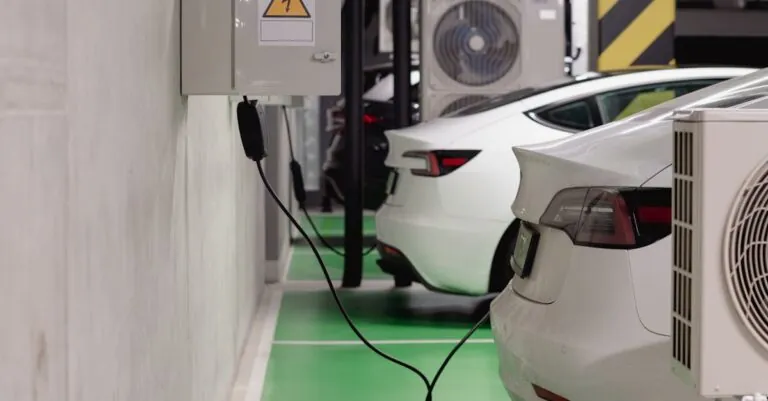Table of Contents
ToggleIn a world where gas prices are climbing faster than a squirrel on espresso, electric vehicles are stealing the spotlight. They’re not just eco-friendly; they’re also turning heads with their impressive efficiency. Imagine cruising around town, saving the planet, and your wallet at the same time. Sounds like a win-win, right?
Overview of Electric Vehicles
Electric vehicles (EVs) represent a transformative shift in personal and commercial transportation. With advancements in battery technology, the driving range of EVs has increased significantly. Many models now offer ranges exceeding 300 miles on a single charge.
Efficiency ratings for EVs often surpass those of traditional gasoline-powered vehicles. For instance, the average efficiency for electric models hovers around 4 miles per kWh, compared to approximately 25 miles per gallon for gasoline vehicles. This stark contrast highlights economic benefits while reducing environmental impact.
Infrastructure development plays a critical role in the adoption of EVs. Public charging stations are expanding, making it easier for drivers to recharge on long trips. Fast-charging stations, available in urban areas and along major highways, enable quick top-ups, attracting more consumers to switch.
Manufacturers, recognizing the growing demand, invest heavily in electric technology. Major automotive companies have committed to producing all-electric lineups within the next decade. Innovative models cater to a variety of consumer needs, from compact cars to SUVs and trucks.
Government incentives further promote the transition to EVs. Tax credits and rebates encourage consumers to make the switch, easing the initial financial burden associated with purchasing electric vehicles. These programs contribute to the decreasing overall costs of ownership, showcasing the financial logic of adopting EVs.
As technology continues to evolve, electric vehicles are set to become more mainstream. Enhanced battery efficiency, lower pricing, and diverse vehicle options indicate a robust future for this sector. Investing in electric vehicles aligns with global efforts to combat climate change, making them an increasingly popular choice for environmentally conscious drivers.
Understanding Efficiency in Electric Vehicles
Understanding efficiency in electric vehicles (EVs) is crucial for both environmental impact and cost savings. Energy consumption metrics and performance parameters determine how effectively EVs utilize electricity.
Energy Consumption Metrics
Energy consumption metrics reflect how much electricity an EV uses per unit of distance. Most electric vehicles average around 4 miles per kWh, highlighting their superior efficiency compared to traditional gasoline vehicles. In contrast, gasoline vehicles typically achieve about 25 miles per gallon. This difference emphasizes the economic advantage of EVs, as lower energy consumption translates to reduced fueling costs. Factors influencing energy consumption include vehicle weight, aerodynamics, and driving habits. Each metric offers insights into how efficiently an EV operates, helping consumers make informed decisions.
Range and Performance
Range and performance are critical for assessing an EV’s practicality. Many modern electric models deliver ranges exceeding 300 miles on a single charge, thanks to advancements in battery technology. Optimal performance often correlates with efficient use of stored energy. Drivers enjoy instant torque and acceleration, providing a responsive driving experience. Fast-charging options significantly reduce downtime, making longer trips feasible. Charging infrastructure continues to expand, further enhancing the convenience of owning an EV. Consumers perceive these attributes as essential factors in choosing electric vehicles.
Top Most Efficient Electric Vehicles
Several electric vehicle models stand out for their remarkable efficiency and innovative features. Here are three of the most efficient options available today.
Vehicle 1: Model Overview and Features
Tesla Model 3 offers a remarkable efficiency rating of approximately 4.1 miles per kWh. It features an impressive range of up to 353 miles on a single charge. This model boasts rapid acceleration, reaching 0 to 60 mph in just 3.1 seconds. Advanced technology includes Autopilot capabilities and a minimalist interior design with a large touchscreen interface. Notably, over-the-air software updates keep performance and features current.
Vehicle 2: Model Overview and Features
Hyundai Ioniq 5 shines with a remarkable efficiency of about 4.4 miles per kWh. It provides an estimated range of 303 miles per charge, making it ideal for long-distance travel. This electric SUV features a spacious interior, rapid charging capabilities, and a unique design that attracts attention. An advanced infotainment system enhances the driving experience with navigation and smartphone integration. Safety features like adaptive cruise control and lane-keeping assist add to its appeal.
Vehicle 3: Model Overview and Features
Ford Mustang Mach-E demonstrates outstanding efficiency, achieving approximately 3.9 miles per kWh. This electric SUV offers a range of up to 312 miles, catering to diverse driving needs. Acceleration from 0 to 60 mph occurs in as little as 3.5 seconds, delivering an exhilarating driving experience. Ford’s SYNC 4 system provides an intuitive interface with connectivity options. Notably, the Mach-E includes a comprehensive suite of safety features, ensuring confidence behind the wheel.
Factors Affecting Electric Vehicle Efficiency
Electric vehicle efficiency relies on several key factors. Understanding these aspects helps consumers choose the right model for their needs.
Battery Technology
Battery technology serves as a cornerstone for EV efficiency. Lithium-ion batteries dominate the market, delivering high energy density and long cycle life. Innovations like solid-state batteries promise even greater efficiency and safety. Advanced thermal management systems also enhance battery performance by regulating temperature during operation. Higher energy capacity directly translates to increased range, minimizing the need for frequent charging. Tesla’s focus on battery development has driven its vehicles to achieve up to 4.1 miles per kWh. Overall, improvements in battery technology continue to optimize the driving experience while reducing energy consumption.
Weight and Aerodynamics
Weight and aerodynamics significantly impact electric vehicle efficiency. Lighter vehicles consume less energy during acceleration and maintain speed more easily. Automakers use lightweight materials like aluminum and carbon fiber to enhance overall efficiency. Streamlined designs reduce drag, allowing cars to glide through the air more smoothly. Improved aerodynamics plays a crucial role in optimizing energy use, especially at higher speeds. For instance, the Hyundai Ioniq 5’s design contributes to its impressive efficiency rating of about 4.4 miles per kWh. Consequently, a focus on minimizing both weight and aerodynamic drag in design ensures better performance and enhanced range.
Future Trends in Electric Vehicle Efficiency
Advancements in battery technology drive future trends in electric vehicle efficiency. Solid-state batteries represent a promising innovation, offering higher energy densities and faster charging times. Improvements in energy consumption metrics indicate how effectively electric vehicles use electricity, helping consumers save on costs.
Vehicle design weighs heavily on efficiency. Research shows that lighter vehicles consume less energy, enhancing overall performance. Aerodynamic designs reduce drag, further boosting efficiency metrics for different models. The Hyundai Ioniq 5 exemplifies this with its sleek appearance, promoting an efficient travel experience.
Expansion of charging infrastructure influences EV adoption rates. Increased availability of fast-charging stations reduces range anxiety among potential buyers. Availability of charging options correlates with higher consumer confidence in making the switch to electric vehicles.
Government incentives shape the market landscape. Tax credits and rebates support consumers seeking electric alternatives, making EVs more financially accessible. These initiatives enhance the attractiveness of electric vehicles, pushing their adoption in various demographics.
Prominent automotive manufacturers focus on producing all-electric lineups. Plans from companies like Ford and General Motors show a clear commitment to the electric future, contributing to overall efficiency trends. The competition among manufacturers fosters innovation, pushing for advancements not just in battery technology but in the overall user experience.
Collaborations between tech firms and automotive companies signify future direction. Partnerships aim to create more integrated software solutions for monitoring energy consumption and offering enhanced user interfaces. These efforts align with consumer expectations for more intuitive technology in their vehicles.
Collectively, these factors indicate that electric vehicle efficiency continues to evolve. Continuous advancements signal a pivotal shift in transportation, bringing electric vehicles further into the mainstream.
The future of electric vehicles is bright as advancements in technology continue to enhance efficiency and performance. With major manufacturers investing in all-electric lineups and governments offering incentives, the transition to EVs is gaining momentum. The combination of improved battery technology and expanding charging infrastructure is addressing consumer concerns while making electric vehicles more accessible than ever.
As the market evolves, efficiency metrics will play a crucial role in guiding consumer choices. The most efficient models not only provide impressive ranges but also contribute to a more sustainable future. This shift represents a significant step toward reducing carbon footprints and embracing cleaner transportation options.







